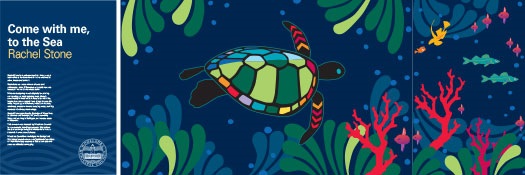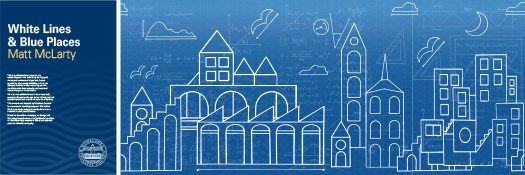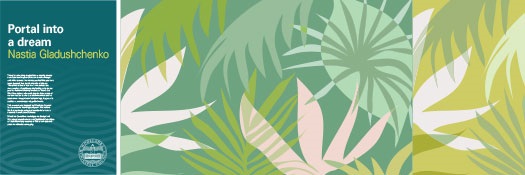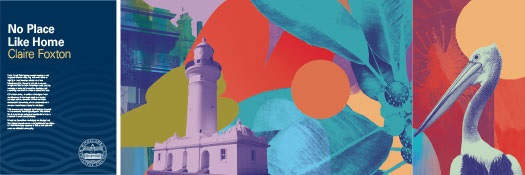Woollahra Creative Hoardings Program
We’re transforming the facades of construction sites into vibrant, artistic spaces with our Creative Hoardings Program.

Artwork by Claire Foxton
We’re committed to working with local artists and diverse industries to find opportunities for creative expression and activation across our municipality – including an ever-growing list of exciting construction projects.
The Woollahra Creative Hoardings Program team works collaboratively with local artists and developers to transform construction sites into vibrant creative spaces, adding colour and storytelling to Woollahra’s streets.
Frequently Asked Questions
What is a creative hoarding?
In broad terms a hoarding is a temporary fencing system placed wholly or partially in a public place to enclose a building site during construction to keep the site secure and the public safe from activities occurring within the site. Hoardings can also serve as a canvas to display creative artwork and transform a construction site from something unattractive to something that sparks curiosity and interest; this is a creative hoarding.
Is a creative hoarding required as part of the hoarding application?
Under Council’s Creative Hoardings Policy a hoarding on public land may require an approved artwork or historic image to be printed on the hoarding.
Applicants must complete the self-assessment checklist to determine if a creative hoarding is required. This is to be done before submitting the Application to erect Hoarding/Scaffolding on Council’s Footpath.
To assist you in completing the checklist, please see the Woollahra Creative Hoardings Guidelines and the Creative Hoardings Artwork Template Guide.
Can I use a custom design for a creative hoarding?
No, you cannot. You may choose from the designs below. Please note that historical image designs are site-specific, and depend on where the development is located.
Can corporate signage or branding be included on the creative hoarding?
A 1.6m wide panel is provided in pre-approved hoarding designs to allow for corporate signage. Site signage required by the Environmental Planning and Assessment Act 1979 and corporate signage together must not cover more than 10% of the overall outer surface area of the hoarding. No advertising of businesses which are not directly associated with the development is permitted.
What is the process of printing and installing the artwork?
You will need to organise the printing and installing of the artwork on the hoarding at no cost to Council. There are a number of large format printing firms in the Sydney region that can print and install graphics on hoardings. Some commercial suppliers of hoardings can also arrange to print and install the graphics as a packaged service.
What is the timeframe to erect a creative hoarding?
The creative hoarding must be erected within three weeks of being approved. Other requirements for the creative hoarding will also be set out in the conditions of the hoarding permit issued by Council.
What are the consequences for non-compliance?
Every effort will be made by Woollahra Creative Hoardings Program team to support you though the process, however If a creative hoarding is required but not erected, penalties consistent with the Local Government Act 1993 and Roads Act 1993 will be considered in accordance with the provisions of the Enforcement Policy.
Council licenced artwork designs
Come with me, to the Sea - Rachel Stone

View larger image(JPG, 62KB)
Rachel Stone’s mural work and her fine art work both reflects her deep love of the natural world: plant, insect and animal.
Rachel shares the sentiment of poet and philosopher John O’Donohue who said that: the beauty of nature is the wisest balm.
Whether designing murals digitally for printing on hoarding, or hand-painting them directly onto freshly minted walls in hospitals and cafés, inspiration comes mostly from things like sea life, birds, frog song, wildflowers, iridescent insects, raindrops, crescent moons, swaying trees, swirling waters and velvety moth wings.
Rachel Stone completed a Bachelor of Visual Arts in Lismore and Brooklyn, NY, and is currently living and working in Bellingen, on the east coast of Australia.
White Lines & Blue Places - Matt McLarty

View larger image(JPG, 63KB)
This is a whimsical interpretation of a classic blueprint; the underlying drafting grid, the cryptic architectural equations. It acts as calming blue curtain shielding us from the disruption within, whilst reassuring us with the clean white lines showing the intent and reason that governs that chaos.
Matt is an established mural artist whose bold, strongly coloured works can be found in school and council installations around the suburbs of Sydney.
Portal into a dream - Nastia Gladushchenko

View larger image(JPG, 49KB)
There is something magical about coming across a wall covered in giant plants on a walk through unfamiliar streets that makes you feel like you have been dropped into the depths of a rainforest.
‘Portal into a dream’ is a work that celebrates these walls and replicates this feeling to immerse you in a lush and dreamy landscape. Nastia is a Blue Mountains artist exploring the importance of our connection to the natural environment and to each other through botanical paintings, large-scale public art, workshops and guided walks.
Burri burri migration - Jordan Ardler

View larger image(JPG, 82KB)
Jordan Ardler is a graduate of UNSW Art and Design, a graphic designer, artist and has experience as a youth worker, volunteer and mentor.
Through her art Jordan aims to shine a light on the ‘unseen’ bringing memories, feelings and emotions to life, and making the invisible visible.
Claire Foxton - No Place Like Home

View larger image(JPG, 47KB)
From Iconic Paddington terrace houses to the majestic Moreton Bay Fig, this work aims to highlight the diversity and charm of the Woollahra LGA. Natural and built attributes mingle in Claire’s colourful collage style, paying homage to the area’s maritime heritage and anchoring the work in a vibrant sense of place.
Claire is an artist, muralist and designer from the Illawarra. In her large-scale works she employs colour, texture and form to depict site-specific narratives, often concerned with the connectedness of people and place.
Postcards of our Local History
Double Bay, Woollahra and Bellevue Hill

View larger image(JPG, 35KB)
Rose Bay, Watsons Bay and Vaucluse

View larger image(JPG, 33KB)
Paddington, Edgecliff and Darling Point

View larger image(JPG, 34KB)
Our Local History Collection can transport you into the history and heritage of our local places and people. Discover a large range of books, manuscripts, photographs, records, maps and other documents which can give insight into Woollahra’s past, and can be used for researching the history of our area.
Essential Documents
Enquiries
For more information, please contact:
Compliance matters:
Telephone: 9391 7097
Email: records@woollahra.nsw.gov.au
Art/design matters:
Telephone: 9391 7124
Email: cultural@woollahra.nsw.gov.au